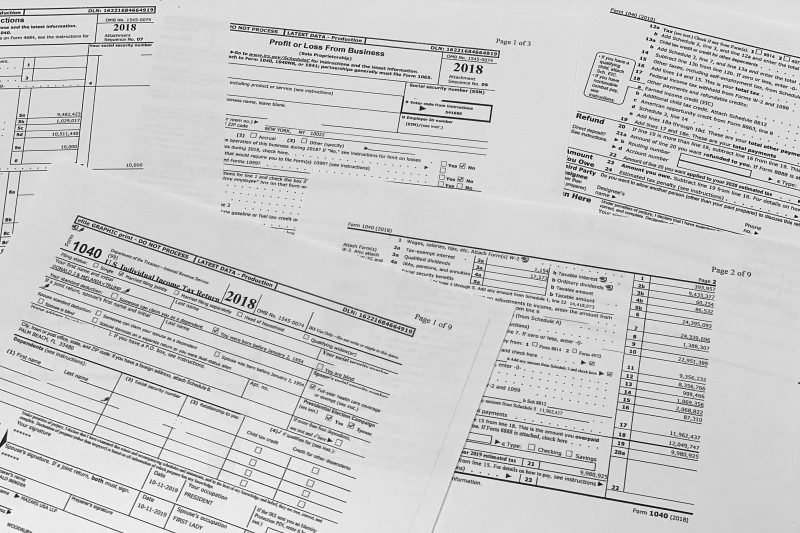Thousands of pages of Donald Trump’s tax returns shed some light on his extensive business empire, both before and during his presidency, as well as his changing fortunes during his time in the Oval Office.
While Trump endured sizable financial losses in the two years before entering the White House, he had an adjusted gross income of $15.8 million during his first three years as president when he paid $1.1 million in federal income tax.
In his final year in office, 2020, he paid no income tax, according to his tax returns that were released Friday by the House Ways and Means Committee. Democrats spent years pursuing the financial documents that previous presidents and White House candidates voluntarily released.
Here is some of what we learned when the returns were first made public Friday.
1. Trump’s fortunes rose and fell, as he aggressively reported losses.
Throughout his campaign and presidency, Trump earned money from a wide variety of sources, from real estate, to his earlier career as a TV personality, to a multitude of businesses like golf clubs and wine. His gross income ran into the hundreds of millions of dollars. But he reported deductions to reduce that income — and the taxes he would owe on it. From 2015 to 2020, he reported a negative adjusted gross income in four out of six years. His reported income ranged from negative $32 million to $24 million.
2. The Trumps contributed inconsistently to charity.
Trump’s charitable contributions declined over the course of his presidency. He donated $1.8 million in 2017, and about half a million dollars in each of the next two years. In 2020, as many nonprofits intensified their calls for donations as they scrambled to help victims of the coronavirus pandemic and the associated unemployment, the Trumps reported giving no money to charity.
3. Trump has bank accounts in several foreign countries and earned money in many nations while he was president.
Trump said in his tax filings that he had completed paperwork required of any American who has a financial account in another country worth more than $10,000. At various times, he said, he had such accounts in China, Ireland, the United Kingdom and St. Martin. He reports earning money in a far longer list of foreign countries.
4. Why did Trump pay any taxes at all? Thank the Alternative Minimum Tax.
Trump reported such substantial losses from his businesses that in many years, his tax bill would have been $0 under ordinary rules for income taxes. But the United States has a system called the Alternative Minimum Tax that is meant to make sure very rich people don’t get away with paying an inordinately low tax bill. In Trump’s case, this alternate calculation method required him to pay at least some taxes in more years than he otherwise would have, by making him add some of his deductions back into his income. The Trumps are among about 200,000 taxpayers subject to this method of calculating their taxes.
5. The Trumps supported the Presidential Election Campaign Fund.
On the Trumps’ tax returns, the opening pages read, “Occupation: President” and “Spouse occupation: First Lady.”
While Americans generally can’t choose what use the government puts their tax dollars toward, there is an exception: Every taxpayer gets to choose whether $3 of their taxes go into the presidential election campaign fund.
Candidates for president can only tap into this fund if they agree to cap their own campaign fundraising in exchange for receiving federal funding. Trump did not participate; no major candidate has since 2008.
But he and Melania did both choose to put $3 into the pot for future candidates to use — making them among only about 4 percent of Americans who chose to contribute to the fund in 2020.
Want to know more? Read more about the release of the returns in our coverage here. Check out the congressional committee’s summary of their findings. And below, find the top numbers from each year of Trump’s taxes.
2015
Adjusted Gross Income: -$31,756,435
Tax based on income and AMT: $2,127,670
Final tax bill after credits: $641,931
Total income: -$31,736,841
2016
Adjusted Gross Income: -$32,409,674
Tax based on income and AMT: $2,234,725
Final tax bill after credits: $750
Total income: -$32,190,169
2017
Adjusted Gross Income: -$12,916,948
Tax based on income and AMT: $7,435,857
Final tax bill after credits: $750
Total income: – $12,819,400
2018
Adjusted Gross Income: $24,395,093
Tax based on income and AMT: $8,356,232
Final tax bill after credits: $999,466
Total income: $24,395,093
2019
Adjusted Gross Income: $4,380,714
Tax based on income and AMT: $558,780
Final tax bill after credits: $133,445
Total income: $4,443,503
2020
Adjusted Gross Income: -$4,795,757
Tax based on income and AMT: 0
Final tax bill after credits: 0
Total income: -$4,694,058



























